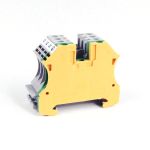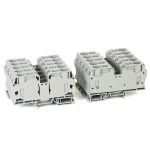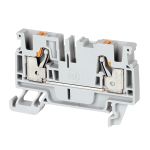Block Party: The Complete Guide to Selecting Allen-Bradley Terminal Blocks
- August 4, 2022
- Best Practices
- Automation

There is nothing inherently sexy about terminal blocks. Everyone needs them for wiring their industrial panels, and they serve a simple purpose. What sets one terminal block apart from the other? Not much. But picking the terminal block that is right for you can save you time and space in your panel.
Here are some things to consider when selecting terminal blocks for your panel.
#1: CONNECTION TYPE
Terminal blocks serve as a connection point when wiring devices in a plant to equipment in a panel. Terminal blocks make wiring devices quick and easy. There are three main types of Allen-Bradley terminal blocks.
Screw: 1492-J Screw-Type Terminal Blocks
Connecting wire to screw-type terminal blocks requires the user to loosen the screw, insert the wire and re-tighten the screw to secure the connection.
Spring: 1492-L Spring-Type Terminal Blocks
To connect wire to spring-type terminal blocks, hold the spring clamp down with a screwdriver, insert the wire and release the spring to secure the connection.
Push-In: 1492-P Push-In Terminal Blocks
If you use a ferrule on the end of your wire, push-in terminal blocks require no extra tools. A ferrule is a metal crimp that keeps the wires together. It works like the plastic aglet on your shoelaces that allows you to lace them through the eyelets. Simply insert the ferrule into the terminal block for a secure connection.
#2: CURRENT AND WIRE SIZE
It is important to pick a terminal block that is rated for the max current of the system, so it does not overheat and cause damage to the terminal block. It is also important to make sure the terminal block is rated for the size of wire you are using, so it will physically fit in the connection point.
#3: AVAILABLE SPACE
Standard terminal blocks are single-circuit feed-through blocks, but to take advantage of space in your panel, it might be helpful to use multi-level terminal blocks. Instead of needing an endless line of single-circuit terminal blocks, take advantage of the vertical space in your panel. Multi-level terminal blocks allow you to have double or triple the number of available connection points at each terminal block. Conserving space with multi-level terminal blocks might also allow you to use a smaller enclosure.
#4: COLOR
Different colors of wire indicate different types of voltage and circuits. Standard terminal blocks are grey, but they can come in a variety of colors for the same purpose. For example, using a red or blue terminal block can make it easier to quickly identify whether it is an AC or DC control circuit.
Van Meter has a variety of Allen-Bradley terminal blocks and accessories in stock. Contact your account manager or inside sales representative to receive a quote or shop online at vanmeterinc.com.

ARTICLE BY:
MATT WAGNER
EMPLOYEE-OWNER, TECHNICAL SPECIALIST - SMART DEVICES


